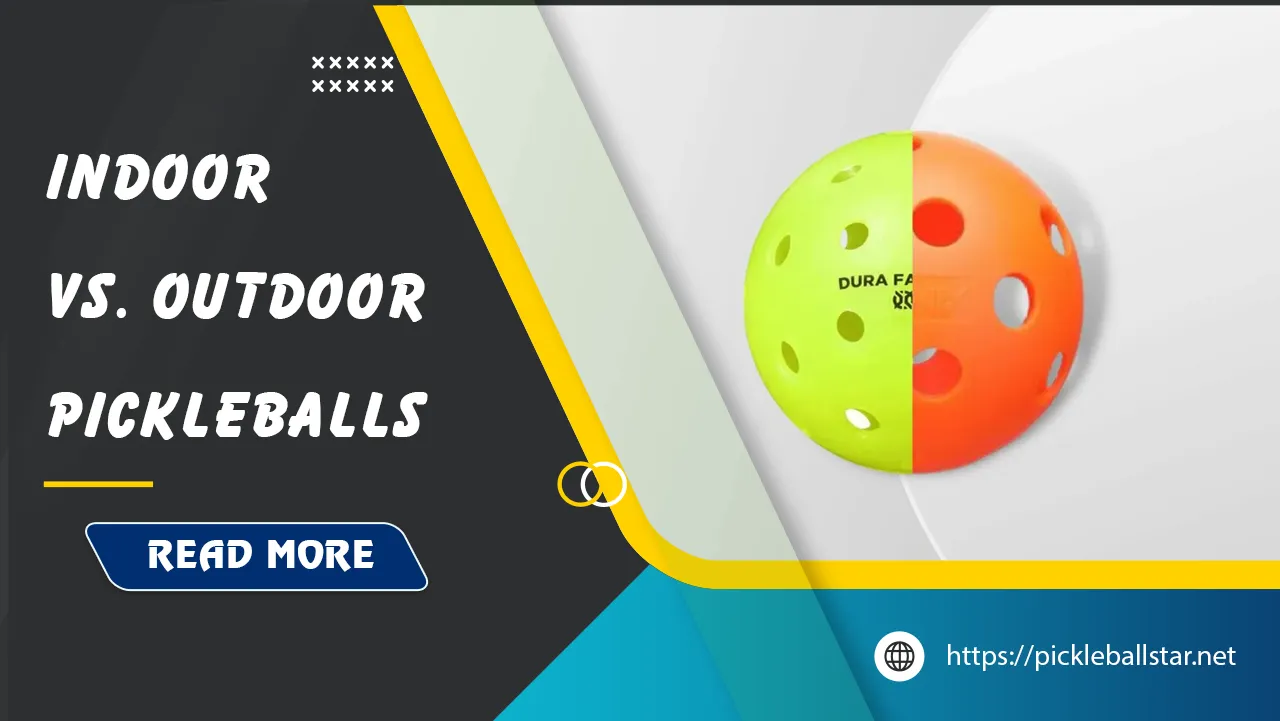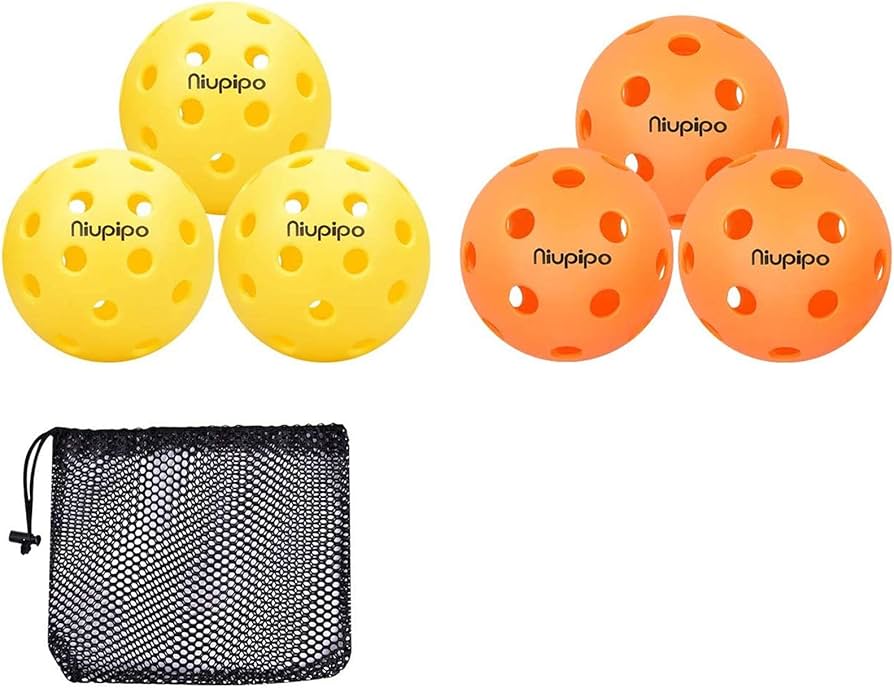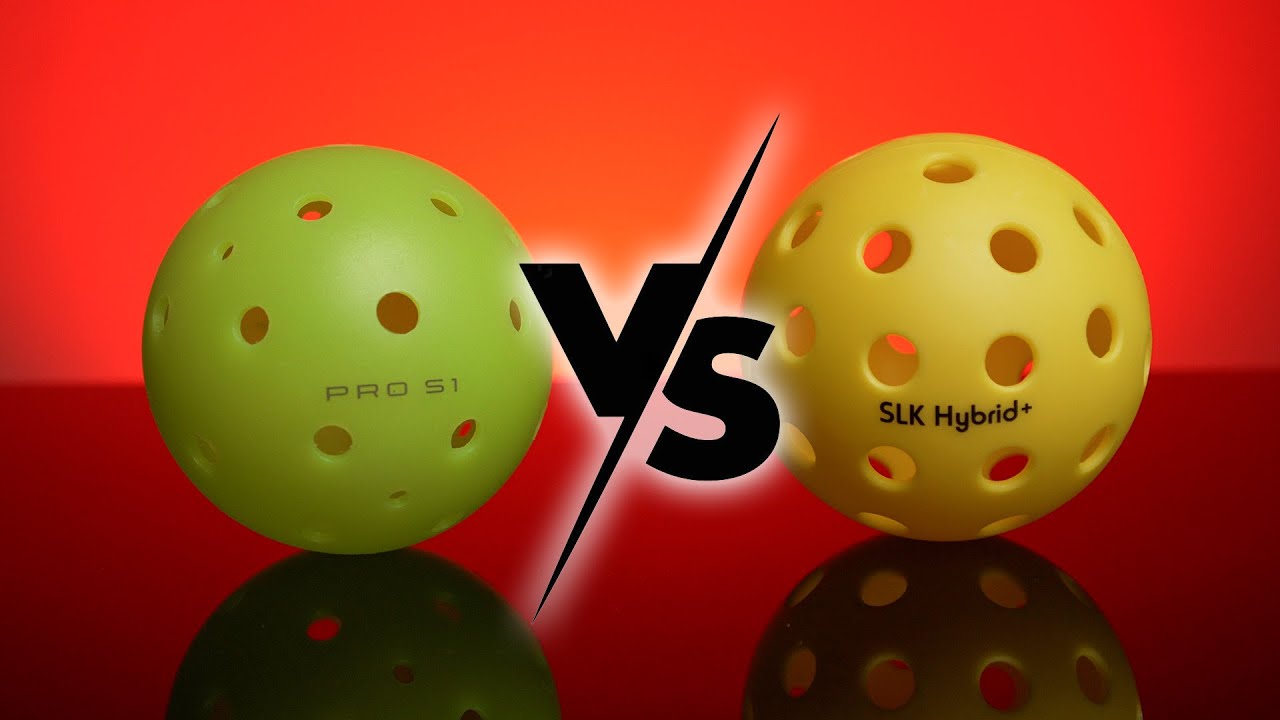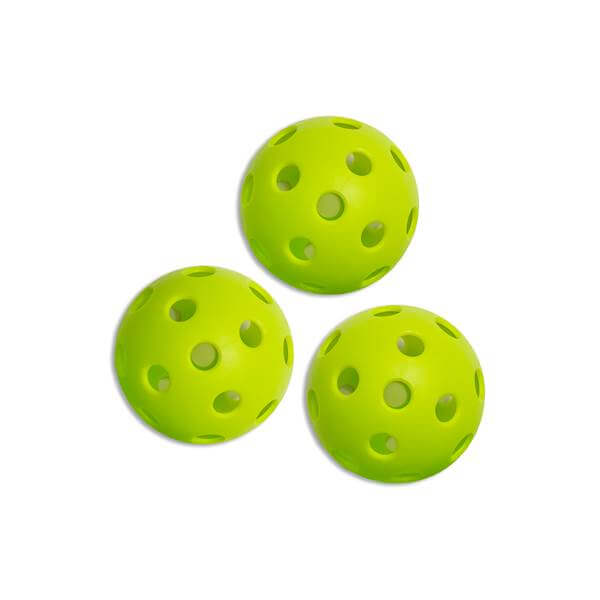Indoor vs Outdoor Pickleballs: The Ultimate Guide
Pickleball, a sport that blends elements from tennis, badminton, and table tennis, has witnessed a surge in popularity. One of the cornerstones for enjoying this game – whether in a gleaming gymnasium or a breezy court outside – is the type of ball you use. At first glance, you might think a ball is just a ball, but in pickleball, there’s a significant difference between indoor vs outdoor pickleballs. This difference is not just a matter of tradition or minor preferences. It directly impacts the gameplay experience.

When I first got into pickleball, I was clueless about these subtleties. I grabbed any pickleball that seemed “good enough” and played wherever I could find space. But as I delved deeper into the sport, the nuances between indoor and outdoor pickleballs became apparent, changing how I approached each game. To appreciate pickleball to its fullest extent, it’s vital to understand why and how indoor and outdoor pickleballs differ.
This guide will walk you through everything you need to know about these variations, helping you choose the right ball for your circumstances and skill level.
What Are Pickleballs?

Pickleballs are the lightweight, perforated plastic balls used in the sport of pickleball. Though they may resemble Wiffle balls, pickleballs are typically more durable and come in distinct varieties designed for different playing environments. During my initial journey into pickleball, I often found myself marveling at the seemingly simplistic design of these balls. However, their simplicity is deceptive as it conceals a complex engineering feat aimed at optimizing gameplay.
These balls are constructed from a high-quality, durable polymer plastic material designed to provide optimal performance on pickleball courts. The deliberate design and materials make them resilient, whether you’re playing in a climate-controlled indoor space or battling the elements outside.
Why Are There Indoor and Outdoor Pickleballs?
The primary reason why there are separate indoor vs outdoor pickleballs is due to the vastly different environments and surfaces on which these games are played. I recall a time when I brought an indoor pickleball to an outdoor court, and it felt like trying to play tennis with a balloon. There was no control, and the wind wreaked havoc on every serve and return.
Indoor pickleballs are specifically designed for the controlled conditions of indoor courts. These balls need to be lightweight and provide more control. On the other hand, outdoor pickleballs are built to withstand harsher conditions like wind, rain, and uneven, rough surfaces, requiring a different set of features for optimized performance.
Key Differences Between Indoor and Outdoor Pickleballs
The differences between indoor and outdoor pickleballs are multifaceted, covering size, weight, number of holes, ball bounce, color, performance, hardness, and durability. Let’s break these down to provide a detailed comparison.

Size and Weight
When you first pick up an indoor vs. an outdoor pickleball, the difference in size and weight might not be immediately apparent, but these attributes are crucial for the ball’s intended use.
- Indoor Pickleballs: Slightly smaller, typically between 2.875 and 2.972 inches in diameter. They weigh between 0.78 to 0.935 ounces. The lighter weight and smaller size offer better control, essential for the more strategic, less aggressive indoor game.
- Outdoor Pickleballs: These balls range from 2.97 to 3.03 inches in diameter and weigh between 0.88 to 0.92 ounces. The added heft aids in stability in windy conditions and provides a more robust feel against the rougher surfaces of outdoor courts.
| Feature | Indoor Pickleballs | Outdoor Pickleballs |
|---|---|---|
| Diameter | 2.875 to 2.972 inches | 2.97 to 3.03 inches |
| Weight | 0.78 to 0.935 ounces | 0.88 to 0.92 ounces |
Number of Holes
The number of holes on a pickleball significantly influences its aerodynamics, affecting control and playability.
- Indoor Pickleballs: Typically have 26 larger holes. These larger holes create more drag, thereby slowing the ball down and making it easier to control, suited for the fast-paced but strategic indoor environment.
- Outdoor Pickleballs: Usually have 40 smaller holes. The smaller holes reduce drag, helping the ball to fly straighter and faster, which is vital for countering wind and other environmental variables.
| Feature | Indoor Pickleballs | Outdoor Pickleballs |
|---|---|---|
| Number of Holes | 26 larger holes | 40 smaller holes |
Ball Bounce
The bounce of the ball varies considerably between indoor and outdoor pickleballs due to differences in surface and ball composition. I remember the surprise of an unexpectedly high bounce when trialing indoor balls on an outdoor court; it genuinely caught me off guard.
- Indoor Pickleballs: Have a higher bounce rate due to their softer construction, providing more spin and control during play.
- Outdoor Pickleballs: With a lower bounce rate, these balls offer more power and speed necessary for the fast-paced dynamics of outdoor play.
Color
Pickleball colors might seem like an aesthetic choice, but it serves a functional role in pickleballs.
- Indoor Pickleballs: Generally made in bright green or other vivid colors to enhance visibility within the controlled lighting of indoor courts. The high visibility ensures that players can spot the ball quickly against varied indoor backdrops.
- Outdoor Pickleballs: Typically come in white or yellow, which stand out best against the natural elements and varied backgrounds of outdoor environments.
Performance
Performance differences in pickleballs impact gameplay significantly.
- Indoor Pickleballs: Their larger holes and lighter weight provide more drag, resulting in a slower, more deliberate game. The added control is a boon for strategic play.
- Outdoor Pickleballs: Offer a faster and less controlled game, thanks to smaller holes and greater weight. This design makes them more capable of withstanding wind and maintaining a more consistent flight path.
Hardness
The difference in hardness between indoor and outdoor balls directly affects gameplay and durability.
- Indoor Pickleballs: Made from softer, more pliable plastic, which facilitates finesse and a controlled pace.
- Outdoor Pickleballs: Constructed from harder, more rigid plastic to endure the harsh conditions of outdoor play and offer more power.
Durability
Durability is a major concern, especially for players who play frequently.
- Indoor Pickleballs: More durable in their intended environment because they’re not subjected to rough surfaces and extreme weather conditions.
- Outdoor Pickleballs: More prone to wear and tear due to the rougher conditions of outdoor play. However, they are built tougher to withstand these stresses.
Indoor Pickleballs
Indoor pickleballs come with their own set of challenges and benefits. I’ve enjoyed many a calm game in an indoor setting where precision and technique take precedence over raw power.

Material
Indoor pickleballs are typically made from a softer plastic material. This softer construction ensures that the ball moves slower, facilitating a game that places a premium on control and precision.
Features
The primary features of indoor pickleballs are designed to complement indoor settings.
- Larger Holes: As mentioned, these balls have 26 larger holes, which increases drag and makes the ball easier to control.
- Lighter Weight: Typically around 0.78 to 0.85 ounces.
Advantages
Indoor pickleballs come with specific advantages designed to enhance the indoor playing experience.
- Consistent Playing Conditions: The controlled indoor environment ensures that factors like wind or uneven surfaces don’t impact the game.
- Gentler on Joints: The lighter weight and softer material reduce stress on players’ joints, making it ideal for extended play.
- Less Noise: The softer material and larger holes produce less noise, making it suitable for shared indoor spaces.
- Enhanced Control: The characteristics of indoor pickleballs make them easier to control, especially beneficial for beginners.
Disadvantages
Despite their benefits, indoor pickleballs come with some limitations.
- Shorter Lifespan on Hard Surfaces: While they do last long indoors, using them on hard surfaces can lead to faster wear and tear.
- Not Suitable for Outdoor Play: Their design is not optimized for windy conditions or rough outdoor court surfaces.
Outdoor Pickleballs
For those who love the thrill of an unpredictable game under the sky, outdoor pickleballs bring a different set of features and challenges.

Material
Outdoor pickleballs are crafted from harder, more durable plastic, built to withstand outdoor conditions, including wind, rain, and rough playing surfaces.
Features
Designed to handle the outdoors, these pickleballs offer distinct features.
- Smaller Holes: Usually have 40 smaller holes to reduce wind impact and stabilize the ball.
- Heavier Weight: Weigh around 0.88 to 0.92 ounces to maintain consistent flight paths in challenging outdoor environments.
Advantages
Outdoor pickleballs shine in their designated setting for several reasons.
- Durable: Built to last, these balls can withstand the rough and harsh conditions of outdoor play.
- Wind Resistance: The smaller holes and additional weight help in maintaining stability in windy conditions.
- Power and Speed: The harder material and increased bounce rate make for a faster, more dynamic game.
- Enhanced Aggressiveness: The dense construction allows for harder, swift shots.
Disadvantages
However, outdoor pickleballs aren’t without their pitfalls.
- Less Control: Their design for speed and power often comes at the expense of control, making precise shots more challenging.
- Harder on Indoor Surfaces: Using these balls indoors can harm softer surfaces and produce more noise, disrupting other activities in shared indoor spaces.
Choosing the Right Pickleball for You
So, how do you decide which pickleball is the right one for you? This choice depends on several factors, including where you plan to play, your skill level, and your personal preferences in gameplay.

Indoor vs Outdoor: Which Is Right for You?
- Playing Surface: If you often play in a gym or an indoor community center, indoor pickleballs are your go-to. Conversely, if most of your games happen on outdoor tennis or basketball courts, outdoor pickleballs are better suited.
- Skill Level: Beginners may benefit from the more controlled, slower-paced indoor balls. Advanced players might prefer the challenge and dynamics of outdoor pickleballs.
- Weather Conditions: In windy or extreme weather conditions, outdoor balls are optimal as they’re designed to withstand and perform under such challenges.
- Playing Style: Choose indoor balls for a strategic, controlled game. Opt for outdoor balls if you prefer a faster, more aggressive game.
When to Use Indoor Pickleballs
Indoor pickleballs excel in environments where conditions are controlled, and gameplay relies on precision and strategy. They are ideal for:
- Gymnasium Floors: Their softer construction won’t damage wooden floors.
- Beginner Sessions: The slower pace and easier control make them perfect for new players.
- Noise-Sensitive Areas: Their quieter nature is better suited for indoor recreational spaces.
When to Use Outdoor Pickleballs
Outdoor pickleballs are designed to thrive under diverse and challenging conditions. They are best for:
- Rough Court Surfaces: Their harder material is resilient against the wear and tear of asphalt or concrete.
- Windy Conditions: The smaller holes and heavier weight improve stability.
- Experienced Players: Those seeking a fast-paced, powerful game will appreciate the responsiveness of outdoor pickleballs.
Multi-Purpose Balls
For players who regularly switch between environments, multi-purpose pickleballs offer a balanced solution. My experience with these balls has been mixed they’re decent but often lack the specific advantage of environment-tailored balls.
- Features: Generally have a medium number of holes (30-35) and a medium weight.
- Flexibility: Suitable for players who play both indoors and outdoors but don’t want to juggle different ball types.
FAQs
Can I Use the Same Ball for Indoor and Outdoor Pickleball Games?
While it’s technically possible, using the same ball for both indoor and outdoor play isn’t advisable. The features that make indoor and outdoor pickleballs perform exceptionally in their respective environments often become limitations outside those settings.
Why Do Indoor Pickleballs Have Larger Holes Than Outdoor Pickleballs?
Indoor pickleballs have larger holes to improve control and stability within a controlled environment. The larger holes allow for more drag, slowing the ball and making it easier to manage. Outdoor pickleballs, with their smaller holes, are designed to handle the unpredictability of outdoor play, providing stability against wind and other elements.
How Does the Weight of Indoor vs Outdoor Pickleballs Compare?
Indoor pickleballs are generally lighter, weighing between 0.78 to 0.85 ounces, which enhances their maneuverability and control. Outdoor pickleballs are heavier, typically around 0.88 to 0.92 ounces, bringing more stability and power to counteract outdoor conditions.
What Happens If I Use the Wrong Ball in a Game?
Using the wrong ball can negatively affect gameplay. An indoor ball used outdoors will struggle with wind and rough surfaces, making it harder to control. Conversely, an outdoor ball used indoors can be too fast and may damage flooring, besides generating more noise.
Conclusion
Understanding the distinctions between indoor vs outdoor pickleballs is essential for optimizing your pickleball experience. Indoor pickleballs offer softer material, larger holes, and lighter weight, making them suitable for controlled, indoor environments. Outdoor pickleballs, with their durable, harder construction, smaller holes, and heavier weight, excel in the unpredictability of outdoor settings.
Choosing the best pickleball balls isn’t just about picking any spherical object; it’s about enhancing your game and ensuring that every serve, volley, and return reaches its full potential. Whether you’re a beginner trying to get a grip on the basics, or an advanced player looking to dominate your match, knowing the right type of pickleball for your playing environment goes a long way in ensuring you have the best gameplay experience possible. So gear up, pick the right pickleball, and enjoy this enthralling sport to its fullest!
